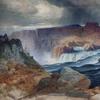Created As a Private Catharsis, The Pictures of Boris Lurie Tell a Story of Survival in New Exhibition
- October 24, 2021 17:58


Boris Lurie: Nothing To Do But To Try is on view now at the Museum of Jewish Heritage–A Living Memorial to the Holocaust. This is a first-of-its-kind exhibition on the 20th century artist and Holocaust survivor and the Museum’s first contemporary art show. The exhibition is centered around Lurie’s earliest body of work (the paintings and drawings inhis so-called “War Series”), as well as never-before-exhibited objects and ephemera from his personal archive, presenting a portrait of the artist reckoning with devastating trauma, haunting memories, and an elusive, lifelong quest for freedom. In drawing together artistic practice and historical chronicle, Boris Lurie: Nothing To Do But To Try is fertile new territory for the Museum of Jewish Heritage, offering a survivor’s searing visual testimony within a significant art historical context. The exhibition will run through April 29, 2022 at the museum, located in lower Manhattan’s Battery Park City.

Boris Lurie (1924–2008) grew up in cosmopolitan Riga, Latvia in the 1930s. He was just 16 years old when Latvia was occupied by the Nazis in 1941, and he and his family were forcibly evacuated to a ghetto. Later that year, his mother, grandmother, sister, and girlfriend were murdered, alongside approximately 25,000 other Jews, in what would come to be known as the massacre at Rumbula. In the years that followed, Lurie and his father together survived several labor and concentration camps throughout Latvia, Poland, and Germany, until liberation from Buchenwald-Magdeburg.
Lurie created his “War Series” in the immediate aftermath of the war, following his service with the United States Counter Intelligence Corps and subsequent immigration to New York. In nearly 100 paintings and drawings made, with few exceptions, in 1946, the “War Series” ostensibly contains Lurie’s experiences of the war in a highly graphic, expressionist style:nightmarish camp scenes in riotous colors, laborers at work in striped uniforms, stark landscapes cut through with barbed wire, amorphous dream-like visions, and searing portraits. As suggested by their somewhat unfinished, chaotic style, as pages ripped from a notebook, Lurie considered these pictures a private catharsis, and never exhibited them in his lifetime.
Included in the exhibition is Lurie’s only known self-portrait as a young man, in which he appears disembodied with a plaintive expression. There is also the exhibition’s largest masterpiece—a ghostly concentration camp scene, 50 by 50 inches in scale, painted in 1971 after the original “War Series” was made.
Nothing To Do But To Try is the first Boris Lurie exhibition exclusively to consider the entire“War Series,” alongside Lurie’s original family photographs, correspondence, diary entries, and assorted ephemera, as an essential origin story for Lurie’s life and work.
“The basis of my art education I obtained in a camp like Buchenwald,” Lurie once wrote, alluding both to his lack of professional training and to how his traumatic experience became rich, if fraught, artistic terrain—his survival itself the ultimate creative act.

“As a person and as an artist, Boris was ingeniously creative, in the sense of bothimaginativeand productive. Foregrounding his life—his biography, belongings, voluminous writings, his surroundings, even his library—in concert with his early artwork reveals a more nuanced portrait of the artist than ever before,” says Guest Curator Sara Softness. “Beyond his immensely expressive artistic talent, the exhibition really considers his devastating emotional life and how he existed in the world—all inescapably informed by his trauma.”

“Our institution is committed to centering the Holocaust’svictims and survivors in our every act of remembrance and education,” says Museum President & CEO Jack Kliger. “We are very honored to present this deeply moving exhibition and to have this opportunity to examine Holocaust history through the artistic brilliance of Mr. Lurie.”
“The Boris Lurie Art Foundation is pleased to have the Museum of Jewish Heritage exhibit thework of Boris Lurie, a mid-century artist, who lived through the horrors of the war and wantedto document the history which would keep the memory alive for a more peaceful future,” saysGertrude Stein, the Foundation’s Director.
The exhibition will be complemented by additional programs exploring Lurie’s life and legacy, including:
● “Rumbula Remembered: 80 Years Since the Mass Executions”(Tuesday, December 7); and
●“Boris Lurie: Searching for Truth in Holocaust Images” (Tuesday, February 1, 2022).
For more detail on these and other events, visit: https://mjhnyc.org/current-events/





















